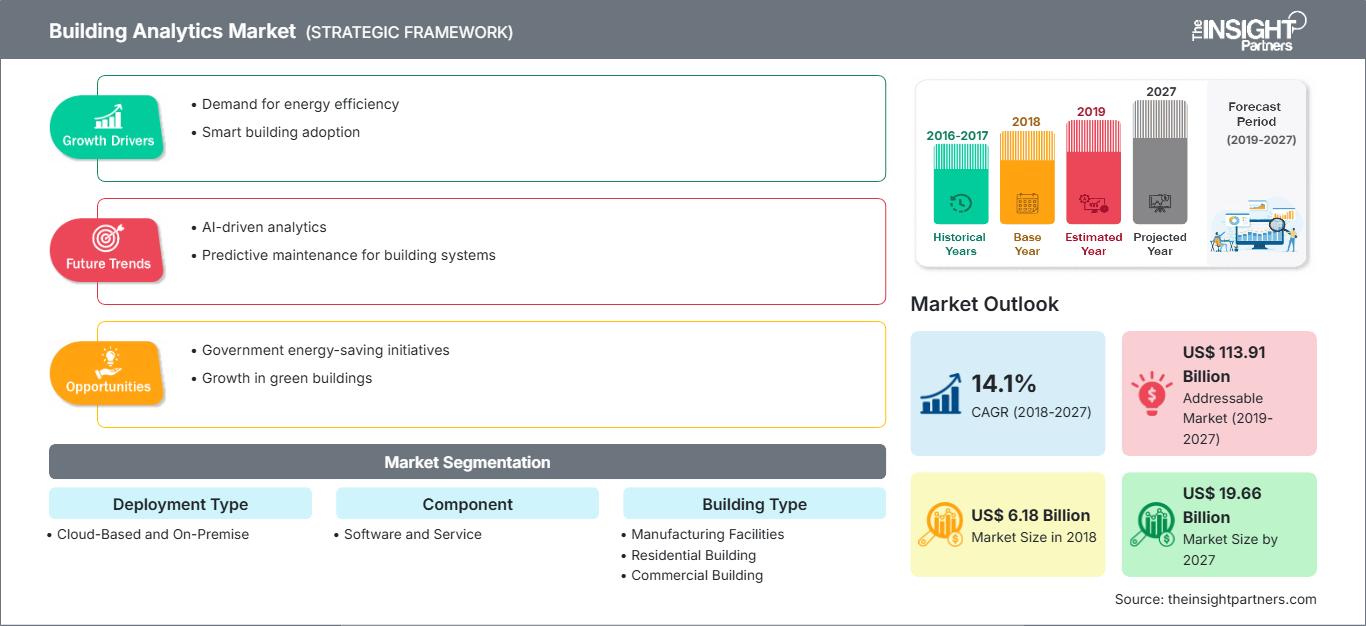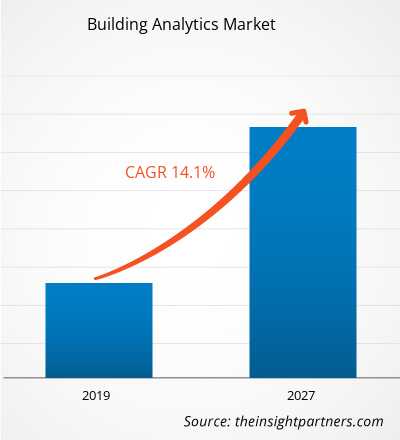The global building analytics market was valued at US$ 6,181.4 million in 2018 and it is expected to grow at a CAGR of 14.1% between 2019 and 2027.
Building analytics market is experiencing growth all across the globe, growing energy prices, increasingly stringent building energy guidelines, and achieving maximum operational efficiency for building and facility management is expected to be the major market driving forces in the coming years.
The report focuses on an in-depth segmentation of building analytics market based on deployment type, component, building type, and application. The geographic segmentation of the report covers five major regions including; North Americas, Europe, Asia-Pacific (APAC), Middle East and Africa (MEA) and South America (SA). The regional market has been further segmented by respective countries. By application, energy management accounted for the largest share in the building analytics market in 2018.
Customize This Report To Suit Your Requirement
You will get customization on any report - free of charge - including parts of this report, or country-level analysis, Excel Data pack, as well as avail great offers and discounts for start-ups & universities
Building Analytics Market: Strategic Insights

-
Get Top Key Market Trends of this report.This FREE sample will include data analysis, ranging from market trends to estimates and forecasts.
The report aims to provide an overview of the global building analytics market with detailed market segmentation. Also, it analyzes the current building analytics market scenario and forecasts the market till 2027. The report covers market dynamics affecting the building analytics market during the forecast period. Furthermore, the report analyzes the competitive scenario, geographic trends, and opportunities in the building analytics market with respect to all geographic regions. The report also includes the detailed company profiles of the key players in the building analytics market along with their market strategies. The report also provides PEST along with the SWOT analysis for all company profiled in the report.
Currently, the building analytics market penetration rates in Europe region is higher than any other markets across the globe. The European Union's Energy Efficiency Directive, launched in 2012 established a set of obligatory measures to aid the EU achieve its 20% energy efficiency target by 2020. The Directive requires all EU countries to use energy more efficiently throughout the energy chain i.e. from production to final consumption. Also, in 2016, an update to Energy Efficiency Directive was proposed, which included a new 30% energy efficiency target for 2030, as well as measures to meet the new target. In the EU, buildings accounts for around 40% of the total energy consumption and 36% of total CO2 emissions. Also, around 35% of the buildings in the EU are more than 50 years old and nearly 75% of the building stock is energy inefficient, although only 0.4-1.2% of the building stock is restored every year. Thus, more restoration of existing buildings has the prospective to lead to substantial energy savings. Such facts provides a prosperous opportunity to the building analytics market growth.
Building Analytics Market Regional InsightsThe regional trends and factors influencing the Building Analytics Market throughout the forecast period have been thoroughly explained by the analysts at The Insight Partners. This section also discusses Building Analytics Market segments and geography across North America, Europe, Asia Pacific, Middle East and Africa, and South and Central America.
Building Analytics Market Report Scope
| Report Attribute | Details |
|---|---|
| Market size in 2018 | US$ 6.18 Billion |
| Market Size by 2027 | US$ 19.66 Billion |
| Global CAGR (2018 - 2027) | 14.1% |
| Historical Data | 2016-2017 |
| Forecast period | 2019-2027 |
| Segments Covered |
By Deployment Type
|
| Regions and Countries Covered |
North America
|
| Market leaders and key company profiles |
|
Building Analytics Market Players Density: Understanding Its Impact on Business Dynamics
The Building Analytics Market is growing rapidly, driven by increasing end-user demand due to factors such as evolving consumer preferences, technological advancements, and greater awareness of the product's benefits. As demand rises, businesses are expanding their offerings, innovating to meet consumer needs, and capitalizing on emerging trends, which further fuels market growth.

- Get the Building Analytics Market top key players overview
Some of the leading players operating in this market are (in alphabetic order) namely: Acorn Engineering Group Limited, Arup Group, AT Kearney, Buildingiq, Buildinglogix, Buildpulse, Coppertree Analytics, Crestron Electronics, Delta Electronics, Ecovox, Energy Advantage, Enernoc, Engie Insight, Environmental Systems Inc., General Electric, Gooee, Gridpoint, Honeywell, IBM Corporation, Iconics, Schneider Electric, Senseware, Siemens, SkyFoundry, Waibel Energy Systems, Xchanging PLC (CSC Computer Sciences International Operations Limited) among others.
- Historical Analysis (2 Years), Base Year, Forecast (7 Years) with CAGR
- PEST and SWOT Analysis
- Market Size Value / Volume - Global, Regional, Country
- Industry and Competitive Landscape
- Excel Dataset
Recent Reports
Testimonials
Reason to Buy
- Informed Decision-Making
- Understanding Market Dynamics
- Competitive Analysis
- Identifying Emerging Markets
- Customer Insights
- Market Forecasts
- Risk Mitigation
- Boosting Operational Efficiency
- Strategic Planning
- Investment Justification
- Tracking Industry Innovations
- Aligning with Regulatory Trends





















 Get Free Sample For
Get Free Sample For